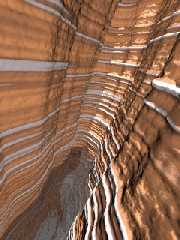|
 |
In article <387### [at] reading ac ac uk>, Michael Andrews
<M.C### [at] reading uk>, Michael Andrews
<M.C### [at] reading ac ac uk> wrote:
> Hi Folks,
>
> There seems to have been a flurry of isosurfaces so I thought I'd add my
> latest experiment.
>
> Made using MegaPoV 0.3, the scene uses radiosity and photons (6259093
> photons shot, 343272 stored. Overkill? Me?). 45min to parse, 4 1/2hr to
> render on a PII 350MHz.
This is wonderful. The only thing I can se wrong with it is the rock
needs more of a rough look to it, maybe a fine scale granite normal.
I love the camera positioning, and the water looks very realistic.
--
Chris Huff
e-mail: chr### [at] yahoo uk> wrote:
> Hi Folks,
>
> There seems to have been a flurry of isosurfaces so I thought I'd add my
> latest experiment.
>
> Made using MegaPoV 0.3, the scene uses radiosity and photons (6259093
> photons shot, 343272 stored. Overkill? Me?). 45min to parse, 4 1/2hr to
> render on a PII 350MHz.
This is wonderful. The only thing I can se wrong with it is the rock
needs more of a rough look to it, maybe a fine scale granite normal.
I love the camera positioning, and the water looks very realistic.
--
Chris Huff
e-mail: chr### [at] yahoo com
Web page: http://chrishuff.dhs.org/ com
Web page: http://chrishuff.dhs.org/
Post a reply to this message
|
 |
|
 |
Superb image. I just wish I had your mathematical skills
Mick
--
*************************************************************
http://www.minda.swinternet.co.uk/index.htm
*************************************************************
Chris Huff <chr### [at] yahoo com> wrote in message
news:chrishuff_99-B1B6FF.11140910012000@news.povray.org...
> In article <387### [at] reading com> wrote in message
news:chrishuff_99-B1B6FF.11140910012000@news.povray.org...
> In article <387### [at] reading ac ac uk>, Michael Andrews
> <M.C### [at] reading uk>, Michael Andrews
> <M.C### [at] reading ac ac uk> wrote:
>
> > Hi Folks,
> >
> > There seems to have been a flurry of isosurfaces so I thought I'd add my
> > latest experiment.
> >
> > Made using MegaPoV 0.3, the scene uses radiosity and photons (6259093
> > photons shot, 343272 stored. Overkill? Me?). 45min to parse, 4 1/2hr to
> > render on a PII 350MHz.
>
> This is wonderful. The only thing I can se wrong with it is the rock
> needs more of a rough look to it, maybe a fine scale granite normal.
> I love the camera positioning, and the water looks very realistic.
>
> --
> Chris Huff
> e-mail: chr### [at] yahoo uk> wrote:
>
> > Hi Folks,
> >
> > There seems to have been a flurry of isosurfaces so I thought I'd add my
> > latest experiment.
> >
> > Made using MegaPoV 0.3, the scene uses radiosity and photons (6259093
> > photons shot, 343272 stored. Overkill? Me?). 45min to parse, 4 1/2hr to
> > render on a PII 350MHz.
>
> This is wonderful. The only thing I can se wrong with it is the rock
> needs more of a rough look to it, maybe a fine scale granite normal.
> I love the camera positioning, and the water looks very realistic.
>
> --
> Chris Huff
> e-mail: chr### [at] yahoo com
> Web page: http://chrishuff.dhs.org/ com
> Web page: http://chrishuff.dhs.org/
Post a reply to this message
|
 |
|
 |
Hi Folks,
Thanks to everyone for their kind words. The feeling of the scene is
close to what I was trying to get - closed in, fairly precarious
viewpoint, the open sky only hinted at by the indirect sky lighting.
Very little math here, just some blobbed shperes and applied noise - a
lot of trial and error. Getting the light to shine down along one wall
and onto half the water, so that only caustics and radiosity light the
other wall, took the most fiddling.
Speaking of trials, I'll include the isosurface function for the image
attached (test image - no photons or radiosity).
I'm working on the texture map at the moment, so I'll leave you to add
your own :-)
Bye for now,
Mike Andrews.
Mick Hazelgrove wrote:
>
> Superb image. I just wish I had your mathematical skills
>
> Mick
>
> --
> *************************************************************
> http://www.minda.swinternet.co.uk/index.htm
>
> *************************************************************
--- start of PoV fragment ---
#declare fnNoise = function { noise3d(x+100,y+100,z*15) +
0.5*sqr(noise3d(x+10,y*50,z+10)) + 0.1*noise3d(x*60,y*60,z*60) }
#declare fnSph = function { "R" }
#declare fnSphB = function { sqr(max(0,1-sqr(fnSph(x,y,z)))) }
#declare vX = 1/0.3;
#declare vY = 1/2;
#declare vZ = 1/1;
#declare vM = max(vX, max(vY, vZ));
#declare fnCanyon = function {
fnSphB(x*vX,y*vY,z*vZ) + 0.15*fnSphB(x*0.5*vX,(y+0.8)*vM,z*0.5*vZ) +
fnSphB(x*0.6*vX-0.5,(y-1.2)*0.5*vX,0) - 0.1
}
isosurface {
function { fnCanyon(x-0.2*(noise3d(10,100,3*z)-0.5),y,z) -
0.1*fnNoise(x,y+0.1*x,z) }
bounded_by { box { -<2/vX,1.3/vY,1.5/vZ>, <2/vX,1.2,1.5/vZ> } }
eval
texture {
function { noise3d(x+10,(y+0.1*x)*50,z+10) }
texture_map {
[ ... ]
}
}
scale 30
matrix <1,0,0, 0.3,1,0, 0,0,1, 0,0,0>
}
--- end of PoV fragment ---
Post a reply to this message
Attachments:
Download 'canyon2a.jpg' (33 KB)
Preview of image 'canyon2a.jpg'

|
 |




![]()